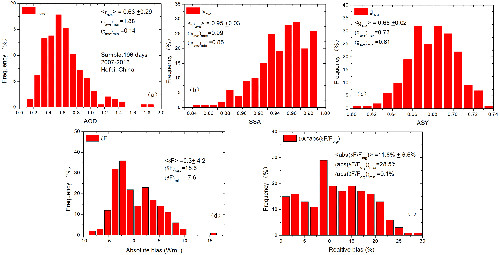Recently, seasonal and diurnal characteristics of aerosol optical properties (AOP), and their impact on calculation of radiative forcing are investigated deeply by lidar study team from center of atmosphere optics of Anhui Institute of Optics and Fine Mechanics (AIOFM), which are useful for assessing radiative effect in a high pollution region. The results entitled Diurnal aerosol variations do affect daily averaged radiative forcing under heavy aerosol loading observed in Hefei, China and Seasonal characteristics of aerosol optical properties at the SKYNET Hefei site (31.90°N, 117.17°E) from 2007 to 2013 has been published in Atmos. Meas. Tech. and J. Geophys. Res. Atmos.
Aerosols alter the radiative balance of the Earth atmosphere system by scattering and absorbing shortwave and longwave radiation directly. Indirectly, aerosols can modify cloud microphysical properties and hence the radiative properties, amount, and lifetime of clouds, which will affect the climate. Especially, estimates of direct aerosol radiative effect (DARF) regionally contain significant uncertainties due to complex aerosol sources, strong diurnal variability, and poorly known morphology. In addition, the diurnal variations of AOP could dramatically affect aerosol radiative forcing calculations and result in significant biases.
Using 7 years of ground-based sky radiometer remote sensing data, the lidar study team investigated the seasonal AOP at the Hefei site in detail The results indicate that High aerosol loading exists in this region throughout the year, while aerosol optical depth during the summer is highest, aerosol particles during the spring is largest, and highest absorption is shown in winter. The effect of using the daily averaged DARF is quantified. The relative biases for 24-h average F calculation are more than 10%. Thus, it is suggested to assess the radiative effects with the measured-retrieved long-term high temporal aerosol data when aiming to obtain accurate radiative transfer calculations in a high pollution region .

the frequency distributions of daily mean AOPs, the corresponding biases for 24-h average F calculation selected in SKYNET Hefei site from 2007 to 2013 (Imaged by WANG Zhenzhu)
Contact:
Dr. WANG Zhenzhu
Anhui Institute of Optics and Fine Mechanics,Chinese Academy of Sciences
Hefei, Anhui 230031, China
Tel: 0551-65591007
E-mail: zzwang@aiofm.ac.cn